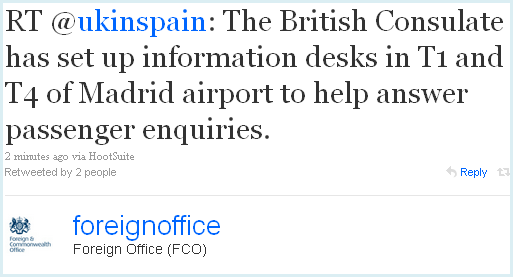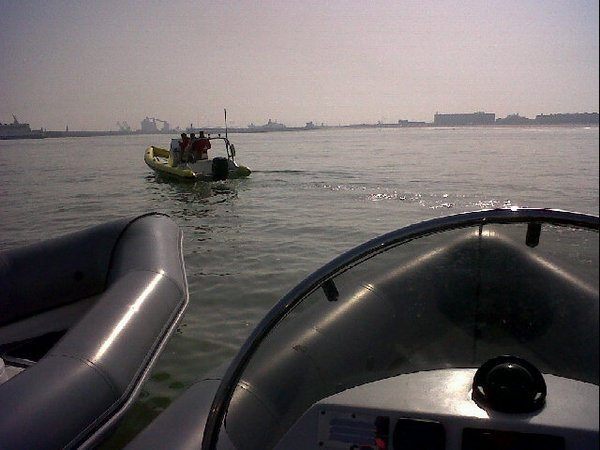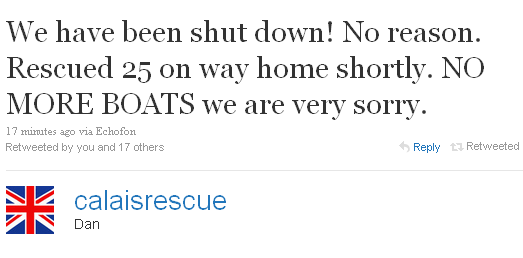by David Steven | Apr 19, 2010 | Cooperation and coherence, UK
My take (1, 2, 3) on complex emergencies such as the Eyjafjallajökull crisis is that governments have to get ahead of the curve, or be steadily choked by competing pressures from scientists, industry, the media, and public.
So what’s coming up on the horizon? At some stage, UK airspace is going to reopen – and there’s going to be an almighty battle for scarce landing and take-off slots. What I want to know is:
- Is anyone working with the airlines to make sure that priority is given to helping Brits stranded abroad or non-Brits stuck in the UK?
- Are there plans to ensure that non-essential flights (e.g. internal flights, commuter planes to Brussels etc.) are the last to be given the chance to take off?
- Can anything be done (sharing flights between airlines, running bigger planes on key routes) to maximize the speed with which schedules return to normal?
I don’t know how long it is likely to take for things to get back to normal – but it’s worth remembering that there could be only brief windows when travel is possible. And that a fresh eruption could quickly make things worse again…
Update (20/4 09.15): Doesn’t sound as if there’s been much coordination as yet.
Frances Tuke, spokeswoman for Abta – The Travel Association… warned that as attempts are made to restore order to travel plans, some of the Britons currently abroad could find those on scheduled flights are allowed to fly before those who have been stuck at airports or hotels for days.
“I don’t have the detailed logistics of what is going to happen,” she added. “I know that some of our bigger members are planning to have conference calls to talk about logistics.”
Update II (20/4 10.15): Another issue to start planning for: travel companies that start to go to bust once they begin paying out refunds. Will the government be forced to step in? Or will it take the heat generated by consumers losing out? And how does the decision get taken during an election campaign?
by David Steven | Apr 18, 2010 | UK
Yesterday, I warned that governments were losing control of the Eyjafjallajökull crisis:
In the UK, it doesn’t help that there’s an election on. But Lord Adonis, the Secretary of State for Transport, is not running for office. It would be good to see greater signs that he – or someone else – is being much more decisive about taking charge.
Apparently, there are more than a million British citizens still stranded abroad and the MET Office has said there will be no flights on Monday 18 April (no confirmation from NATS on that as yet). Both the media and airlines are clearly getting restless. A new narrative is crystallizing: that the threat from the ash cloud has been substantially exaggerated.
Albeit belatedly, British ministers have finally shown they are now more fully engaged with events, with five lining up in Downing Street for a press conference. COBRA will meet tomorrow morning.
In my opinion, however, the Foreign and Commonwealth Office should be much more specific about what its consular staff are doing. I’m talking about concrete and detailed briefing for the media.
How is it using its consular surge capacity (the Rapid Deployment Team)? How many extra staff have been deployed? In which airports does it have staff dealing directly with passengers and airlines? How, practically, are these staff managing to assist people?
The generalities on the FCO website are not nearly enough… [Relatedly: KLM masters social media. Air France fails.]
Update [19/04 9.30 am]: A few other thoughts. The UK government social media response has – so far – been distinctively unimpressive, despite the fact that many government departments, the FCO included, have very good social media team. (Good this morning, though, to see the gov Twitter feeds finally starting to use the Twitter #ashtag and #ashcloud tags)
In contrast, Eurocontrol – which oversees European airspace – has emerged as a model of best practice. Whoever it behind its Twitter feed is doing a stellar job – detailed factual updates, numerous responses to people’s questions, and all in an identifiably human voice.
Also, the pressure is clearly building on governments to downgrade the threat, based on test flights. But, say, a plane had a 1/1000 risk of getting into trouble (e.g. hitting a slightly thicker patch of ash during its flight), then you could run a dozen or so tests and have a very slim chance of hitting trouble. So you open Heathrow, which has 1300 flights every day…
Once again, the complex risk calculations at the heart of this crisis are making Anthony Giddens’s 1999 Reith lecture look very prescient:
There is a new moral climate of politics, marked by a push-and-pull between accusations of scaremongering on the one hand, and of cover-ups on the other. If anyone – government official, scientific expert or researcher – takes a given risk seriously, he or she must proclaim it. It must be widely publicised because people must be persuaded that the risk is real – a fuss must be made about it. Yet if a fuss is indeed created and the risk turns out to be minimal, those involved will be accused of scaremongering.
Suppose, on the other hand, that the authorities initially decide that the risk is not very great, as the British government did in the case of contaminated beef. In this instance, the government first of all said: we’ve got the backing of scientists here; there isn’t a significant risk, we can continue eating beef without any worries. In such situations, if events turn out otherwise – as in fact they did – the authorities will be accused of a cover-up – as indeed they were.
Things are even more complex than these examples suggest. Paradoxically, scaremongering may be necessary to reduce risks we face – yet if it is successful, it appears as just that, scaremongering. The case of AIDS is an example. Governments and experts made great public play with the risks associated with unsafe sex, to get people to change their sexual behaviour. Partly as a consequence, in the developed countries, AIDS did not spread as much as was originally predicted. Then the response was: why were you scaring everyone like that? Yet as we know from its continuing global spread – they were – and are – entirely right to do so.
This sort of paradox becomes routine in contemporary society, but there is no easily available way of dealing with it. For as I mentioned earlier, in most situations of manufactured risk, even whether there are risks at all is likely to be disputed. We cannot know beforehand when we are actually scaremongering and when we are not.
When dealing with risk, governments are almost always going to emerge at least somewhat discredited. The question is how badly
Update II [19/04 16.30]: The FCO website is still maddeningly unspecific. For example:

Meanwhile, here’s Marcus Fairs with some information that’s (i) much more specific and helpful; (ii) directly covers what named FCO consular staff are up to.

Also, it is increasingly clear that NATS – the UK’s air traffic control organisation – is floundering. No Twitter feed. A website that is still in emergency mode. And, worst of all, official updates on their site, but leaks to other news organisations with different information. Not good.
Update III [20/04 14.30]: Finally:

by David Steven | Apr 18, 2010 | Europe and Central Asia, Global system

Superb photo from NASA:
The MODIS instrument on NASA’s Aqua satellite captured an Ash plume from Eyjafjallajokull Volcano over the North Atlantic at 13:20 UTC (9:20 a.m. EDT) on April 17, 2010.
More coverage from Global Dashboard here and here. (h/t @TomRaftery). Plus: two great animations of the ash cloud dispersing over Europe (1, 2).
by David Steven | Apr 18, 2010 | Cooperation and coherence, UK
When crisis strikes, it doesn’t take long for people to start finding ways to help themselves.
On 9/11, a self-organising flotilla began to evacuate people from Manhattan even before the Twin Towers fell. Katrina saw the same improvised response.
The Coast Guard did not act alone in its sizeable rescue effort. An emergent and ephemeral flotilla of civilian boat operators also converged on the heavily damaged areas, both on their own initiative and in response to a call for assistance by political leaders. The ability of Coast Guard operational commanders to act relatively autonomously in the field, a strong-hold of experienced personnel, versatile training, an organizational environment that combines uniformed and civilian operations, and the development of a shared vision of what was necessary by both Coast Guard and civilian boat operators facilitated the ability to improvise at a multi-organizational level.
Interestingly, one of New York City’s most dramatic (albeit rarely mentioned) improvised response activities on September 11th, 2001 was the waterborne evacuation of Lower Manhattan… The harbor community did not have plans to execute a mass evacuation of the City, but vessels converged—again, some on their own initiative and others in response to the Coast Guard’s call for all available boats—to improvise a successful evacuation of hundreds of thousands of people. In fact, ferries, tugs, dinner cruise boats, and other private vessels played an even more significant role in the operation than actual Coast Guard vessels. This same operation quickly became involved in transporting critical equipment, supplies, and personnel to Manhattan on return trips to collect more evacuees
Today saw an attempt by Dan Snow to organize a Dunkirk-style evacuation from France, for those unable to get a plane home after Eyjafjallajökull shut down European airspace (more on Europe’s slow motion crisis, here).

Dan has been tweeting as calaisrescue. Unfortunately, it seems the authorities have not taken too kindly to his efforts, bringing the rescue effort to a halt after just three boat loads got away:

It’s not yet clear exactly what happened (I am guessing a health and safety issue) – but any attempt to stamp on bottom-up resilience seems extremely short-sighted. After all, the 2003 European heat wave was such a disaster precisely because people didn’t help their neighbours.
The decision to stamp on the rescue could also make an interesting campaign theme for David Cameron, who has put the Big Society (and resilience, too) at the heart of his bid for office, providing a good example of where the state (presumably the French one, in this case) crowds out community-led initiative.
[BTW those interested in community resilience should read Charlie Edwards’s Resilient Nation – as well as these talks (1, 2) for RUSI.]
Update: BBC says ‘French officials’ took the decision… though there appear to be efforts ongoing to get the show back on the road.
by David Steven | Apr 17, 2010 | Europe and Central Asia, UK

As the Eyjafjallajökull eruption continues, my sense is that the crisis is beginning to become quite serious (check out radar of Europe’s empty skies). Lots of people have been stranded for a significant period of time now – many in difficult conditions. Some are being told not to expect a flight home for a week or more.
And that’s if the ash cloud clears quickly. At the moment, there are no signs of this happening (for recent info, see Erik Klemetti’s blog). The volcano is still erupting, albeit at a lesser intensity – but high pressure means that the cloud is not going anywhere. A renewed eruption is possible, while the bigger neighbouring volcano, Katla, is reported to be showing increased seismic activity.
That could be a very big deal:
The danger is that the small volcano is just the beginning and that it will trigger the far more powerful volcano of Katla, which nestles beneath Myrdalsjoekull.
“That has to be on the table at the moment,” Dave McGarvie, senior lecturer at the Volcano Dynamics Group of the Open University, said. “And it is a much nastier piece of work.”
Icelanders agree. “This could trigger Katla, which is a vicious volcano that could cause both local and global damage,” Pall Einarsson, from the University of Iceland, said.
There is an immediate need to get those stranded abroad home. The FCO finally has an emergency consular hotline up and running (+44 207 008 0000) for British citizens stranded abroad (not on the website as yet, though, as far as I can see), and hopefully other countries are implementing crisis plans as well.
There are also encouraging signs of people helping themselves, with bottom-up resilience being facilitated by social media (also this Dunkirk evacuation – loading now in Calais). On Twitter, the #getmehome tag is worth watching as, of course, are the main tags: #ashtag #ashcloud (also – a good list of Twitter resources here).
But I’d like to see some coordination by and between European governments. It is absolutely absurd that people are having to buy bicycles to be allowed to board a cross-Channel ferry. Soon, we are going to need a much more coordinated evacuation.
Beyond that, I am wondering how healthy European airlines are. Are any facing immediate cash flow problems as they face demands for refunds and are forced to shell out to put stranded travellers in hotels? How long can each one keep going if flights remain grounded? A bailout probably needs to be considered. A stress test of the industry’s stability would be a useful first step.
Finally, it’s worth exploring the longer-run consequences if this develops into a major Black Swan event. Is there anything that can be done to keep planes flying should there be a chain of eruptions over months or a year or more (maybe not, but it’s worth exploring)? And is there a risk of serious damage to Europe’s fragile economy, or can we be sure regular interruptions to aviation pose no systemic threat?
I can’t help thinking of the European heat wave of 2003. That was one of the continent’s “worst ever peacetime disasters, but we barely noticed it at the time and have forgotten it remarkably quickly.” The volcano is unlikely to cause 35,000 deaths, of course, though the risk to health could worsen depending on the changing composition of the ash.
But the heat wave should remind us how bad we are at responding to a slow motion crisis – and that resilience may be at its lowest ebb when we don’t take a threat seriously enough until it is too late.
In the UK, it doesn’t help that there’s an election on. But Lord Adonis, the Secretary of State for Transport, is not running for office. It would be good to see greater signs that he – or someone else – is being much more decisive about taking charge.
Update: Both KLM and Lufthansa are itching to get flying again (have a look though at these pics of damage to a Finnish airforce jet – also the experience of this Ural Airlines flight is not encouraging):
KLM, the Dutch subsidiary of Air France, said Sunday it wants to resume passenger flights in Europe as soon as possible after it flew a plane through the cloud of volcanic ash covering much of the continent without suffering any damage.
KLM carried out the test flight above Dutch airspace Saturday. It said initial inspections afterward showed no damage or irregularities from the ash in the air that has led to a ban on air travel over much of Europe since Friday.
The airline says it now plans to return seven airplanes without passengers to Amsterdam from Duesseldorf Sunday.
“We hope to receive permission as soon as possible after that to start up our operation and to transport our passengers to their destinations,” said Chief Executive Peter Hartman, who was aboard Saturday’s flight.
Germany’s Lufthansa flew 10 empty planes to Frankfurt from Munich at low altitude on Saturday under so-called visual flight rules, in which pilots don’t have to rely on their instruments.
Update II: Robert Patterson – and in the comments, @aem76us, wonder what longer-term disruption of air traffic might look like…
Update III: I think the media is getting desperate to find a new angle on this story – and that means having someone to blame. FCO, Department for Transport – if you’re not 100% on top of the situation, they’re coming for you…
Update IV: Sure enough, the Conservative Party has issued an eight-point action plan for beefing up the response to the crisis. John Redwood calls for a cross-Whitehall review of what can be done. And, finally, Brown will chair a Ministerial meeting. I’d say the government allowed itself to get at least 48 hours behind the curve.
Update V: Watching the latest Eurocontrol press conference and many journalists seem to be coming to the conclusion that governments should be blamed for exaggerating the threat from the ash cloud. Airlines are also pushing this line. Here’s a statement from Olivier Jankovec of Airports Council Europe:
With 313 airports paralysed at the moment, the impact is already worst than 9/11. More than 6.8 million passengers have been affected so far and European airports have lost close to €136 million. Many thousands of passengers are still stuck at airports because of this situation. While safety remains a non-negotiable priority, it is not incompatible with our legitimate request to reconsider the present restrictions.”
Absolutely clear, that governments are losing – or have lost – control of the narrative now…







